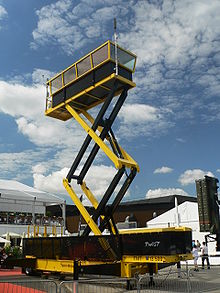- Control tower
-
A control tower, or more specifically an Air Traffic Control Tower (TWR), is the name of the airport building from which the air traffic control unit controls the movement of aircraft on and around the airport. Control towers are also used to control the traffic for other forms of transportation such as rail transport (see illustration below), sea port or moveable bridges. Most of the world's airports are non-towered or mandatory frequency — only a minority of airports have enough traffic to justify a control tower, though some airports may open temporary tower units during special events like an airshow. Control towers are also located on aircraft carriers.
Permanent control tower structures generally rise high above other buildings at an airport to give air traffic controllers a view of aircraft moving on the ground and in the air around the airport, though temporary tower units may operate from trailers or even portable radios outside.
Medium-traffic airports may have only one controller staffing the control tower, and may not keep the tower open 24 hours per day. Busier airports usually have space for several controllers and other support staff, and operate 24 hours per day, 365 days per year.
Features
Full control tower structures usually have windows that circle the entire top floor, giving all round vision. The windows are usually tilted outwards at 15 degrees, because otherwise the controllers would see the reflection of their equipment. The ceiling may also be painted black.[1]
Control towers typically contain the following:
- radios for communication with aircraft, linked to controllers' headsets or to microphones and speakers;
- a telephone system that connects dedicated voice lines and public telephone lines via quick-dial systems to controllers' headsets, allowing them to talk to other controllers and outside parties;
- a strip board allowing Flight Progress Strips to be used (however in some towers these have been replaced by a computerised system);
- a light gun for communication with aircraft via aviation light signals in the event of a radio failure;
- wind and pressure gauges.
- Cab glass may be impact resistant laminated, or the typical insulated annealed glass. Testing includes the determination of acceptable tolerances regarding double imaging.
Other equipment may include the following:
- a rotating beacon;
- an aerodrome traffic monitor, which is a small radar display that is not used for separation purposes but allows controllers to see the aircraft flying in the vicinity of the airport;
- a surface movement radar displaying aircraft and vehicles on the airport to assist controllers at night and in poor visibility;
- computerized meteorological information, flight data and briefing systems.
Records
The world's highest control tower is Vancouver Harbour Control Tower, situated on top of the 142 meter skyscraper 200 Granville Square, in downtown Vancouver, Canada. The world's tallest free standing control tower is the 132.2 m (434 feet) Suvarnabhumi Airport control tower, 25 km east of Bangkok, Thailand.
The very first control tower for an airport was built in 1925 in Cleveland Hopkins International Airport.
Gallery
-
The distinctive tower at Nuremberg Airport
-
London Luton Airport control tower
-
George Bush Intercontinental Airport control tower
-
Sydney Airport control tower
-
The control tower of a small airfield: Kemble Airport, England
-
The interior of the tower at Seattle-Tacoma International Airport
-
Tallest control tower in the world - Suvarnabhumi airport control tower
-
The control tower at Leeds Bradford International Airport sits atop the pasenger terminal.
See also
Air Traffic Control (ATC)
Federal Aviation Administration (FAA)
Terminal Radar Approach Control (TRACON)
Virtual Air Traffic Simulation Network
Interlocking towers or signal boxes are terms used for control towers in the railroad industry.References
- ^ LiveScience.com Why Do Air Traffic Control Towers Have Slanted Windows?
External links
Categories:
Wikimedia Foundation. 2010.














